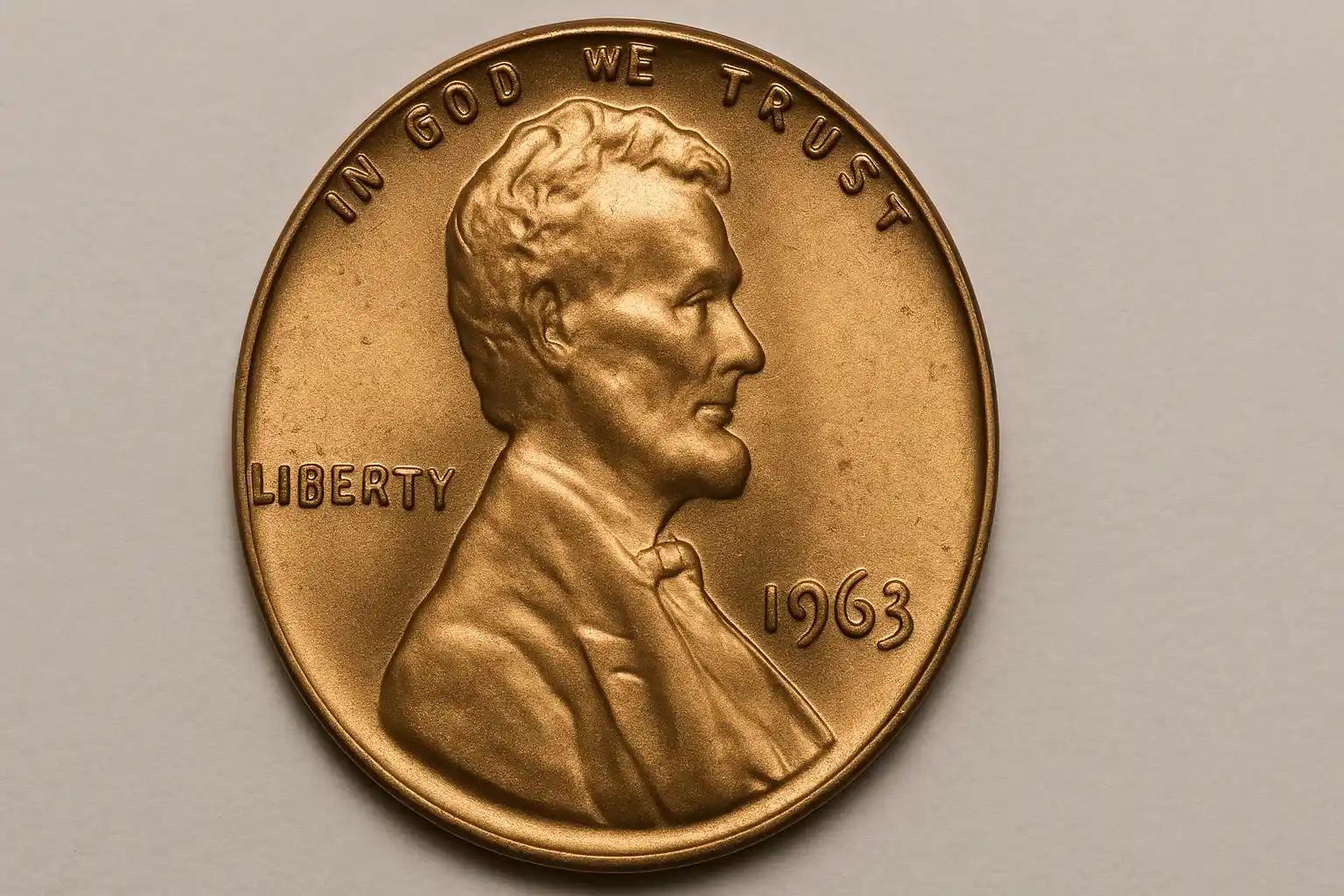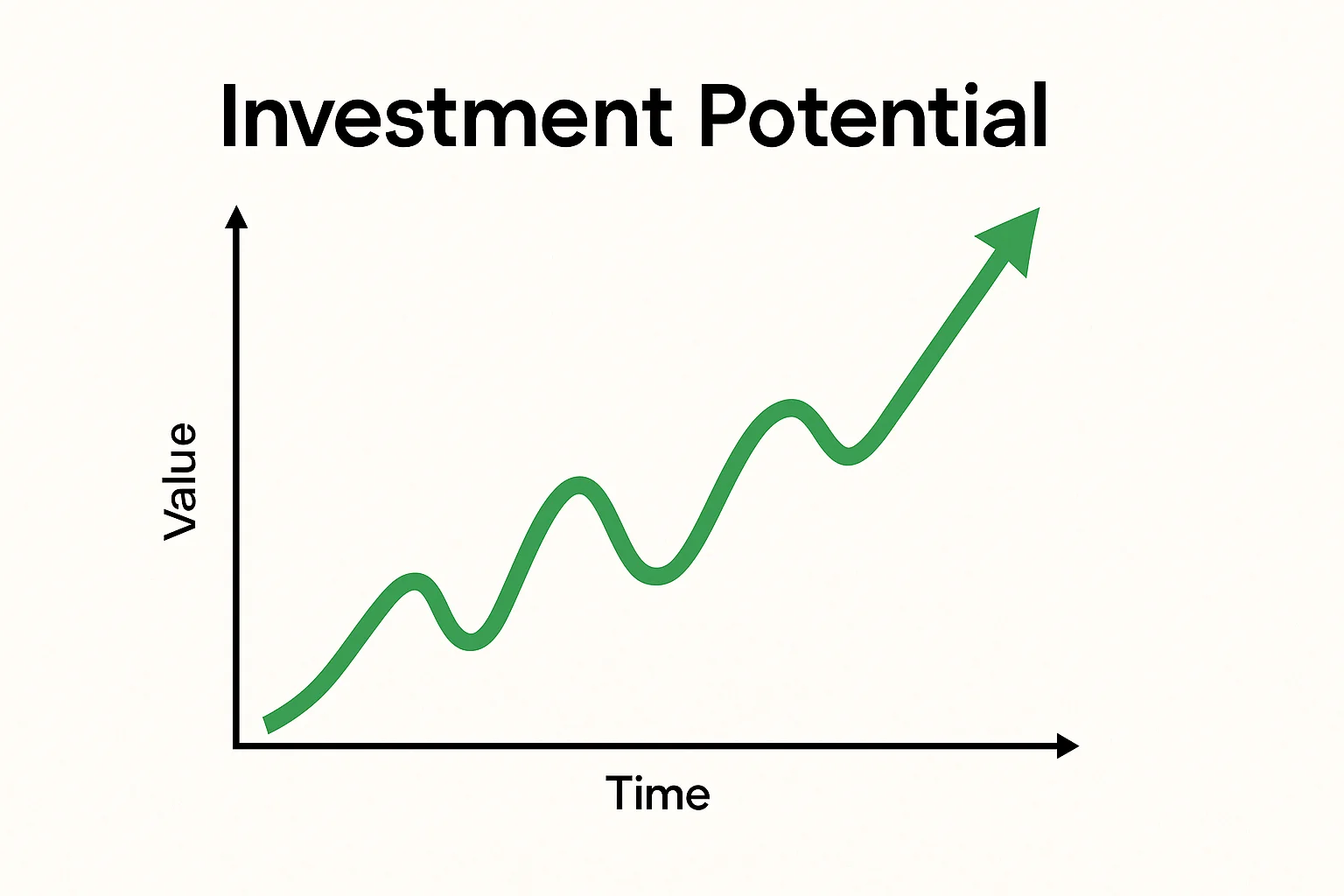The 1963 penny value is related to a Lincoln Memorial cent, part of the long-running Lincoln cent series first introduced in 1909. It features Abraham Lincoln on the obverse and, starting in 1959, the Lincoln Memorial on the reverse.
Obverse (front): Portrait of Abraham Lincoln, designed by Victor David Brenner. Inscriptions include LIBERTY, the date 1963, and the motto IN GOD WE TRUST.
Reverse (back): The Lincoln Memorial in Washington, D.C., designed by Frank Gasparro, with the inscriptions UNITED STATES OF AMERICA, E PLURIBUS UNUM, and ONE CENT.
Composition: 95% copper, 5% tin and zinc (the traditional bronze alloy used until 1982, when the Mint switched to copper-plated zinc).
Weight: 3.11 grams
Diameter: 19 millimeters

Mintage
Philadelphia (no mint mark): Over 754 million coins
Denver (D): Over 1.75 billion coins
San Francisco (S, proof): About 3.07 million coins
There were no proof coins struck in Philadelphia that year, but the San Francisco Mint did produce proof coins for collectors, bearing an “S” mint mark.
1963 Lincoln Cent Value Chart
Variety | Circulated (Good–XF) | Uncirculated (MS60–MS64) | High Uncirculated (MS65–MS67 RD) | Proof (1963-S) |
1963 (Philadelphia, no mint mark) | Face value (1¢) | $1 – $3 | MS65 RD: $10 – $25 MS66 RD: $40 – $75 MS67 RD: $200+ | — |
1963-D (Denver) | Face value (1¢) | $1 – $3 | MS65 RD: $10 – $20 MS66 RD: $30 – $50 MS67 RD: $150+ | — |
1963-S (Proof only) | — | — | — | PR65: $5 – $10 PR67: $15 – $25 PR69 Cameo: $60+ PR69 Deep Cameo: $150–$300+ |
Circulation coins are extremely common due to high mintage and are almost always worth only face value.
Red (RD) graded coins command much stronger prices than Brown (BN) or Red-Brown (RB), since full copper luster is rare after 60 years.
Proofs from San Francisco are widely collected, and Cameo or Deep Cameo contrasts dramatically increase their worth.
Top-graded coins (MS67 or PR69+ with strong color/contrast) are scarce and bring premiums at auction.
Errors
Doubled Die Errors
Some 1963 cents show signs of doubling caused during die hubbing. On the obverse, doubling may appear in the motto IN GOD WE TRUST, the date, or the word LIBERTY. Reverse doubled dies can show extra thickness in the lettering of UNITED STATES OF AMERICA or ONE CENT. Strong doubled dies are scarcer and desirable, while minor mechanical doubling adds little premium.
Repunched Mint Marks (RPMs)
On the 1963-D cents, the “D” mint mark was hand-punched into the die, which sometimes left visible secondary impressions. Collectors seek out RPM varieties such as D/D north, D/D east, or tilted mint marks. Depending on clarity and grade, these can bring several dollars to $50 or more.
Off-Center Strikes
When the blank planchet is not properly seated in the press, the dies strike only part of the coin, leaving a crescent of blank metal. Small off-centers (less than 10%) are modestly collectible, but dramatic examples showing 50% of the design missing — especially if the full date is visible — can sell for $100 or more.
Clipped Planchets
A blank cut too close to the edge of a metal strip results in a coin missing a curved or straight piece along the rim. A 1963 penny with a large, obvious clip is immediately recognizable and can bring premiums from $10 to $50, with dramatic or multiple clips worth more.
Broadstrikes
If a coin is struck without the restraining collar, it spreads outward, producing a wider, flatter penny with weak or missing rims. A broadstruck 1963 cent is easy to identify by its oversized look. Premiums vary, typically $25 to $100 depending on sharpness and grade.
Die Breaks and Cuds
As dies wear, they sometimes crack or break, leaving raised lines or blobs of metal on struck coins. Small die cracks are common, but large cuds (where part of the die face breaks away) are scarce. A cud that interrupts lettering or Lincoln’s portrait can add strong collector value, sometimes over $100 for dramatic examples.
Struck-Through Errors
If debris such as grease, cloth, or wire gets between the die and planchet, the coin can show missing or indented details. Struck-through errors are highly individual and can range from small grease strikes (minor value) to dramatic objects leaving full impressions, which are much more collectible.
Wrong Planchet Strikes
Although rare, a 1963 penny could be struck on a blank intended for another denomination, such as a dime planchet. These are highly prized because they are instantly obvious — the coin would be underweight and smaller in size but carry a cent design. Prices often run into the hundreds when authenticated.
Investment Analysis
Market Position
The 1963 cent sits at the transition point between the Wheat cent era (ended in 1958) and the long Lincoln Memorial run. With more than 2.5 billion struck between Philadelphia and Denver, the coin is common in every circulated grade. As a result, its base-level investment potential is low. The real value lies in high-grade condition rarities, proofs with cameo contrast, and certified errors.
Condition Rarity
Most survivors from 1963 are Brown (BN) or Red-Brown (RB) due to copper’s natural tendency to tone. Fully Red (RD) examples in MS66 or higher are scarce and command strong auction prices. Over time, populations of such coins will shrink further as coins tone, meaning certified Red examples are positioned for gradual long-term appreciation. Registry set competition for Memorial cents ensures continued demand at the top end.
Proof Market
The 1963-S proofs are abundant in lower grades but show strong premiums in Cameo and Deep Cameo designations. Collectors of proof Lincoln cents often pay significantly more for deep frost and mirror contrast. Since cameo-quality pieces are scarcer, particularly in PR69, this is where the best upside lies. These coins already bring hundreds of dollars at auction and will likely remain stable or rise gradually.
Error Appeal
Off-centers, broadstrikes, and repunched mint marks continue to attract specialists. Unlike common coins, these errors are genuinely scarce — no new supply can appear, and demand has remained consistent. Prices for large off-center 1963 cents with full dates, or for dramatic RPMs, are steady and show potential for modest appreciation as error collecting grows more mainstream.

Long-Term Outlook
Circulated examples: No investment potential; billions exist.
Uncirculated MS65 and below: Stable but oversupplied; unlikely to grow significantly.
High-grade Red coins (MS66–MS67): The strongest growth area; scarcity and registry pressure keep premiums firm.
Proof Cameo/Deep Cameo: Consistently in demand; niche but reliable investment path.
Errors: Strongest potential for percentage gains; appeal lies in visibility and scarcity.
Investment Strategy
For investors, the goal is to avoid common circulated or low-grade Mint State coins and focus on certified Red MS66+, PR69 Cameo/Deep Cameo proofs, and dramatic certified errors. These categories hold true scarcity and collector demand, making them far more likely to appreciate. Lower-end pieces remain fun for collecting but carry little financial upside.
5-Year Value Projection
Type / Condition | Current Approximate Value | Projected Value in 5 Years |
Common circulated coins | ~ $0.01 (face value) | Still face value; modest increase only if copper prices rise significantly or if specific circulation strikes become more difficult to find in nice condition. |
Uncirculated MS60–MS63 (no color designation) | ~$1–$3 | $2–$5 range for MS60–MS63 if surfaces are clean; moderate growth as fewer coins remain in that untouched state. |
Red (RD) certified uncirculated – MS65–MS66 | Currently ~$15–$30 for MS65-RD; MS66-RD examples sell higher (some listings around $20-$60 depending on grade and seller). | In five years, well-graded RD MS66 examples could fetch $50–$100+, especially if coin population aging reduces supply. MS65-RD may rise into the $25-$50 range, depending on eye appeal and toning. |
Proof / Cameo / Deep Cameo examples (1963-S) | Proof pieces with cameo or strong finish may hold premiums; common proofs often trade for $5-$30 depending on grade. | Could rise to $40–$100+ for the finest Deep Cameo or cameo proofs in top grades, as fewer coins remain in premium proof condition. |
Major Errors / Varieties (strong RPM, widespread doubled dies, dramatic off-centres) | Currently major error 1963 pennies can trade in hundreds depending on the error’s severity. Some listings show MS66 RD values about $20-$100+ for non-error coins, but dramatic error coins already go higher. | In five years, well authenticated and dramatic error coins could see 50-100%+ gains (e.g. $300 becoming $600-$1000+), especially with increasing demand from error collectors and scarcity of show-piece errors. |
These projections assume the coins are properly certified by recognized grading services (PCGS, NGC, ANACS, etc.), which helps in maintaining trust and value.
Red color designation (RD) holds far more premium than Brown (BN) or Red-Brown (RB). Many coins tone over time, decreasing the population of full RD examples.
Market demand needs to remain stable or increase; if interest in Lincoln Memorial cents wanes, even high-grade coins may stagnate.
Major errors and varieties always carry the highest upside because supply is strictly limited; no new authentic dramatic errors will appear once known examples are catalogued.
Best-Case / Worst-Case Projection
The 1963 Lincoln Memorial cent sits in an interesting position: extremely common in circulation but showing real potential in condition rarities, proofs, and dramatic errors. For the average circulated coin, value will remain at face, with no realistic growth. The real story lies in certified Red MS66–MS67 coins, cameo proofs, and rare mint errors.
In a best-case scenario, continued demand for Lincoln Memorial cents and steady registry set competition could push MS66 RD coins into the $75–$100 range, deep cameo proofs into the $150+ tier, and major errors into the $600–$1,000 bracket.
In a worst-case scenario, if collector interest cools or the modern market shifts heavily toward newer series, prices may stagnate. In that case, MS65–MS66 RD coins would hover in the $20–$40 range, proofs would remain modest at $20–$50, and only the largest dramatic errors would retain strong premiums.
For investors, the safest path is targeting the top 5–10% of survivors — coins with undeniable eye appeal and third-party certification. These represent the strongest hedge against market fluctuations and the most likely candidates for long-term appreciation.

